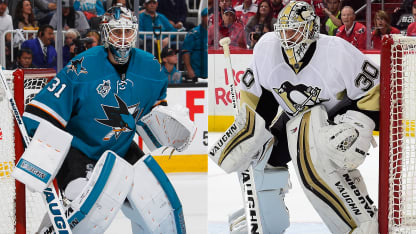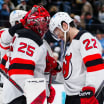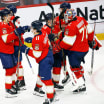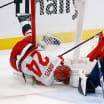Goaltending plays an integral part in the Stanley Cup Playoffs so NHL.com is breaking down the battle between the pipes in each series this season, charting goals to find strengths, weaknesses and targetable tendencies. Here's a look at the matchup in the Stanley Cup Final.
So much for experience being a key component for a goaltender during a run to the Stanley Cup Final.
Sharks goalie Jones has edge on Penguins' Murray
Positioning, post play key elements in column of San Jose goaltender

By
Kevin Woodley
NHL.com Independent Correspondent
The San Jose Sharks' Martin Jones is in his first season as a No.1 goalie, and 22-year-old Pittsburgh Penguins rookie Matt Murray has played more games (15) in the Stanley Cup Playoffs than he has in the regular season (13).
It hasn't always been perfect; Murray was replaced by veteran Marc-Andre Fleury as the starter for Game 5 of the Eastern Conference Final before returning to make saves on 44 of 47 shots in winning Games 6 and 7 against the Tampa Bay Lightning, and Jones was pulled in Game 4 of the Western Conference Final against the St. Louis Blues when he allowed four goals on 19 shots, part of a three-game stretch in which he gave up nine goals on 66 shots (.864 save percentage).
Overall, each goaltender has managed to recover quickly from stumbles by sticking with the playing styles that got him this far in the first place.
Because experience doesn't appear to be a big factor, let's take a closer look at each goalie's techniques and tactics, as well as some of the strengths and weaknesses that have been revealed during these playoff runs.
POSITIONING: Jones' style and positioning match the calm demeanor Sharks teammates often praise. He plays a patient, controlled game, wandering only slightly past the top of his crease on rush chances but staying inside the blue ice on end-zone play, and challenging only when he reads a clean chance. He got caught chasing the play wide of his crease a handful of times in the playoffs, and almost always during or after moving to his blocker side, but has mostly stuck with the contained approach that forces shooters to beat him around the perimeter of the net, because he's almost always in the middle of it.
Murray plays a similarly controlled game, mostly staying inside or in contact with the edge of the blue ice, though he did get caught a little farther out on rush chances against the Lightning, including on a 3-on-1 goal by Jonathan Drouin in Game 1 that left himself little chance to get across in time. He also has shown a tendency to overplay the short side on wide-angle chances, which left him exposed to a backdoor rebound in Game 1 against Tampa Bay. Murray also can get a little flat and off angle with his retreats off the rush, which has left him vulnerable to well-placed high shots on the far side a few times in the playoffs, including a shot over the glove on a partial breakaway by Rick Nash of the New York Rangers in the first round and Drouin's against-the-grain shot in Game 7 of the conference final.
Advantage: Because Murray has been caught moving more as the playoffs have gone on, Jones.
BLOCK/REACT THRESHOLD: Jones showed off his reactive abilities with a couple of tough saves in the series-clinching Game 6 win against St. Louis in the conference final but relies more on positioning and tight defensive play to force opponents to make perfect shots under pressure. He is at his best when he stays patient on his skates and keeps his hands active, but his size and positioning allow him to succeed even when he starts pushing to the ice with his knees, straightening his upper body and pulling back with his hands on the release in more of a blocking mode. Those tendencies leave him exposed high and cause delays and coverage deficiencies in his recovery movements, and that can be targeted with traffic because he prefers to look over screens. That leaves him exposed along the ice and under the pads, something that led to two goals against the Los Angeles Kings in the first round and a go-ahead power-play goal on a point shot in Game 5 against the Blues. Ten of the 17 goals allowed by Jones against the Nashville Predators in the second round involved rebounds, broken plays and screens.
Murray is at his best tracking down from an engaged stance but got caught arriving late and pulling off shots late in the second round and early in the conference final. He switched from a "handshake" glove position to a "fingers-up" approach during the season but tracks shots and moves better to his blocker and tends to lower his glove shoulder early, something that has been exposed throughout the playoffs.
Advantage:Because he tracks and reacts more, and despite the glove issues, Murray.
PUCKHANDLING: Neither goalie handles the puck a lot, but neither is scared to come out of his net to make a short pass or set up a puck for the defense behind the net, something Murray showed with a couple confident handles amid the pressure of Game 6 against Tampa Bay.
Advantage: Because there doesn't appear to be much to choose from, it's a draw.
POST PLAY:Jones uses a variety of post-integration techniques depending on the type of attack and its proximity to the goal line. He still uses a traditional VH, with the lead pad stacked vertically against the post and the back pad lying horizontal on the ice, on plays above the goal line. He prefers reverse-VH, with the post pad down on the ice and the back skate dug in to push him into the post seal and steer his rotation around the post, when the puck is behind the net. He won't linger in either too long, and though he was burned five-hole a few times by opening up on wraps and walkouts during the season, it has only cost him two goals in the playoffs so far: a backhand in tight and under the pad by Nashville's Ryan Johansen in Game 6 of the second round, and Vladimir Tarasenko's bank shot off the fingers under his blocker after he pulled ever so slightly off the post too soon toward the end of Game 6 against the Blues.
Murray mostly uses reverse-VH on his posts and is mobile moving in and out of it, something he showed off with a cross-crease push to rob Ondrej Palat early in Game 1 against the Lightning. He has been caught down on his posts early with the puck above the goal line a couple of times, however, including the fourth goal before being pulled in Game 4 against Tampa Bay, and his preference for going paddle down can leave him exposed high on the blocker side, something the Washington Capitals turned into a sharp-angled goal in Game 4 of the second round. Murray also got caught wandering too far outside his post on an overtime wraparound goal by T.J. Oshie in Game 1 against the Capitals, and a lack of rotation cost him a key goal in Game 6.
Advantage: Because he gets better rotation around his posts and uses several techniques, Jones.
SCORING TRENDS: Most goalies have one direction they move better. For most, including Jones, it's to the glove, but Murray actually gets better natural rotation in angle when moving to his blocker side and is more likely to come across flat, sometimes even backing across the crease, going toward his glove. Although most of the focus has been on Murray getting beat high on the glove side throughout the playoffs, and it's true his shoulder drops on that side earlier than his blocker, several of the high-glove goals start with a poor movement habit to that side. That includes three goals against the Lightning; Murray started his right-to-left move with a reverse c-cut of his left skate, essentially backing across before rotating into angle, which put him behind on the play and unable to square up to the shot.
Jones' conservative positioning leads to more stereotyped exposure around the edges of the net. Seven of the 17 goals scored by Nashville in the second round were into the high corners, but several required near-perfect shots just inside, or off, the posts. He gave up an uncharacteristic four goals "through" his coverage in the conference final, including the game-winner on a long rush shot under the glove-side arm in Game 1. More often than not, however, he forces teams to beat him with good shots rather than beating himself by opening up. If there is a notable trend, it's his movement to the blocker side, which lacks early rotation and leaves him moving flat across the crease laterally to his right, a trend that has led to chasing some plays past his right post and left him stranded outside his crease.
Advantage: It may well depend on which of these usually stingy defenses allows the other team's potent offense time and space to exploit the above-listed tendencies, but because his are more limited, Jones.

















